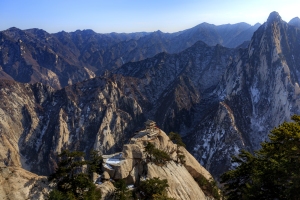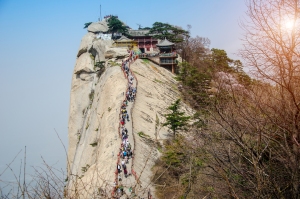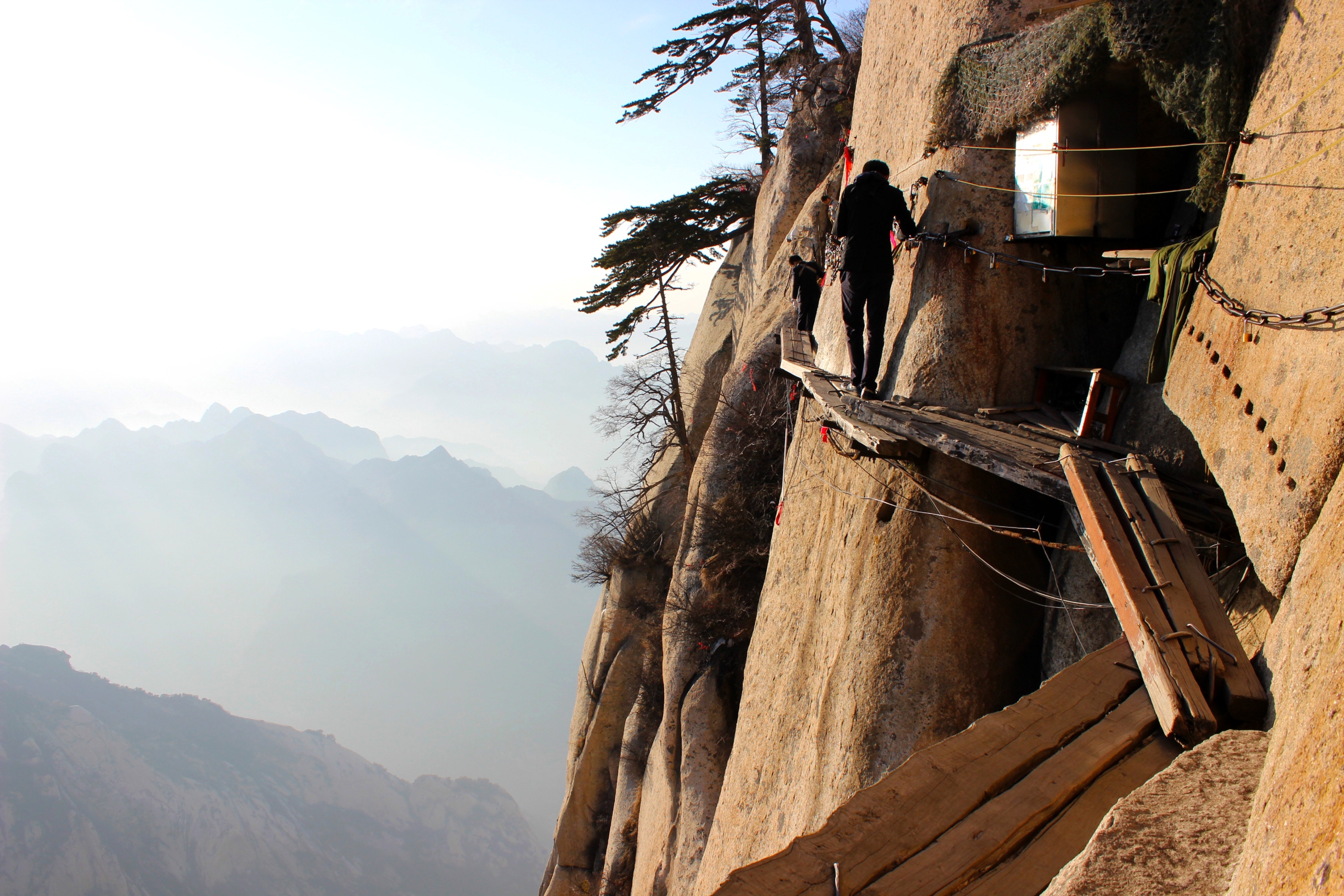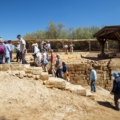In the heart of China’s Shaanxi province, Mount Huashan rises through shifting mists and sheer cliffs. For centuries, it has been a site of inner exploration and ascetic discipline. Today, its renowned trail presents an extreme challenge that attracts pilgrims, hikers, and adventure seekers alike.
The most infamous section, the Plank Walk, is often called the “trail of death”—narrow wooden planks bolted to a vertical rock face, ancient footholds carved into stone, and rusted chains providing the only support. A single misstep can be fatal, yet thousands set out on the journey each year.

A Path Steeped in History
Mount Huashan is one of China’s Five Great Mountains, a pilgrimage destination for over two thousand years. In Taoist tradition, it was regarded as a bridge between the earthly realm and higher planes of existence. Legends tell of hermits who could traverse its peaks with superhuman lightness, moving between the rocks like spirits.
The first trails date back more than a thousand years, carved directly into the mountain’s cliffs. Originally, the path was reserved for Taoist practitioners who accepted the extreme risk as part of their spiritual journey. Over time, Huashan’s trails earned a reputation as more than just a test of faith—they became a test of physical endurance and courage.
The Plank Walk: When the Void Lies Beneath Your Feet
The most feared section of the trail is the Plank Walk, a wooden path barely half a meter wide, fastened to a sheer rock face. There are no railings, only aging chains to grip while the drop below plunges hundreds of meters down.
Today, visitors wear safety harnesses, but the experience remains unnerving. Many advance with their backs pressed against the rock, avoiding looking down to keep fear at bay. Some freeze midway, others turn back trembling. Stories of falls and accidents fuel the mountain’s ominous reputation, though official statistics on fatalities remain undisclosed.

Stairways to the Sky and Knife-Edge Ridges
The Plank Walk is not the only challenge. Reaching it requires navigating steep staircases hewn into the rock, worn smooth by centuries of use and lacking side barriers.
One of the most demanding sections is the Heavenly Stairs, an almost vertical flight of steps that seems to ascend directly into the sky. Further ahead, a razor-thin ridge forces hikers to proceed with extreme caution, with sheer drops on either side.
Despite modern safety measures, the risks remain real, and Mount Huashan continues to be regarded as one of the world’s most dangerous trails.
Faith, Challenge, and Adrenaline
Why do people take on such a perilous journey? For some, it is a spiritual experience. The Taoist temples atop the peaks are considered sites of powerful energy, and reaching them after overcoming fear and exhaustion holds deep significance.
For others, the draw is the challenge itself. Mount Huashan is one of the few remaining places where risk is tangible, where the thrill of walking between sky and earth, with the wind cutting across the cliffs and the heart pounding in excitement, is a rare and exhilarating experience.
Huashan Today: Between Spirituality and Tourism
In recent years, Mount Huashan has seen a surge in visitors. Safety harnesses and new installations have made the trail more accessible, yet its essence remains unchanged. Taoist monks still meditate in secluded hermitages, while modern hikers—backpacks strapped on and smartphones in hand—face the same fears and obstacles that pilgrims have encountered for centuries.
Huashan is a place of contrasts: ancient and modern, asceticism and adventure, inner search and physical endurance. For those who find the courage to take on the trail, it is more than just a hike—it is a journey into the depths of one’s own limits.
Mount Huashan: Did You Know?
Name origin: “Huashan” means “Flower Mountain,” named for its five peaks, which resemble the petals of a blossoming flower.
Highest temple: The Jade Emperor Temple, located on the main peak, stands at 2,154 meters (7,067 feet).
Famous hikers: The Plank Walk has been crossed by climber Alex Honnold, known for his free solo ascents.
Local legends: Some stories claim that monks discovered the elixir of immortality on Huashan’s peaks, making the mountain a site of spiritual pursuit even today.
If you ever find yourself in China and feel drawn to Mount Huashan, know that it is more than an extreme hike. It is a test of limits, a confrontation with fear, and perhaps, a chance to touch the sky.
Just make sure your harness is securely fastened before you begin.





